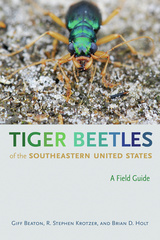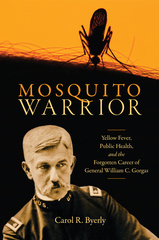
208 pages, 8 3/4 x 11 1/2
557 illustrations
Hardcover
Release Date:29 Mar 2013
ISBN:9780817317812
Mosquitoes of the Southeastern United States
University of Alabama Press
Mosquitoes of the Southeastern United States is a full-color, highly illustrated guide to the sixty-four known species of mosquitoes in eleven genera that populate the South—from the Gulf Coastal states to the Carolinas. In addition to detailed and fully illustrated identification keys for both larvae and adults, it includes information on the mosquito’s lifecycle, interaction with humans, and biological diversity in the southeast.
This area of the country has a rich mosquito fauna with diverse species ranging from the tiny pitcher plant mosquito to the brilliantly colored cannibal mosquito. Close-up photographs of live adults showcase their widely varied and beautiful bodies while remarkable images made with the aid of a microaquarium reveal the differences in larval stages of the subjects. For each species described, Nathan D. Burkett-Cadena provides biological information including distribution maps, habitat associations of the larvae and adults, range of animals fed upon, and importance from a medical standpoint.
This book’s usefulness to mosquito control programs in the Southeast and beyond cannot be overstated. Not only for native species, but for new species introduced from exotic locales, mosquitoes must be properly identified in order to know how best to control them. This volume will also be valuable to medical and public health specialists working on mosquito-borne diseases, such as malaria, dengue, yellow fever, West Nile virus, and filariasis. Mosquitoes of the Southeastern United States is the first guide to integrate full-color photography, illustrated keys, and current information on the biology of mosquitoes into one definitive resource.
This area of the country has a rich mosquito fauna with diverse species ranging from the tiny pitcher plant mosquito to the brilliantly colored cannibal mosquito. Close-up photographs of live adults showcase their widely varied and beautiful bodies while remarkable images made with the aid of a microaquarium reveal the differences in larval stages of the subjects. For each species described, Nathan D. Burkett-Cadena provides biological information including distribution maps, habitat associations of the larvae and adults, range of animals fed upon, and importance from a medical standpoint.
This book’s usefulness to mosquito control programs in the Southeast and beyond cannot be overstated. Not only for native species, but for new species introduced from exotic locales, mosquitoes must be properly identified in order to know how best to control them. This volume will also be valuable to medical and public health specialists working on mosquito-borne diseases, such as malaria, dengue, yellow fever, West Nile virus, and filariasis. Mosquitoes of the Southeastern United States is the first guide to integrate full-color photography, illustrated keys, and current information on the biology of mosquitoes into one definitive resource.
When all of the segments of this book are put together—lengthy discussions, illustrated keys, and color plates—it offers an excellent manual for the identification of mosquitoes and a study of the biological elements helpful to mosquito-control agencies. Those responsible for providing vector control will be better able to understand the details of mosquitoes and their biology by using this book. Also, instructors of medical entomology will be able to use this manual to teach the segment on Culicidae.’
—Richard F. Darsie Jr., coauthor of Identification and Geographical Distribution of the Mosquitoes of North America, North of Mexico
The photos in Mosquitoes of the Southeastern United States are wonderful and unmatched for many of the species. The addition of information on each species provides valuable species-specific characteristics that may not be available in some of the programs and certainly not in the textbooks for environmental health personnel. This book fills a long-needed gap in our knowledge of the mosquitoes of Alabama. Adding those in Georgia, Mississippi, South Carolina, North Carolina, and Tennessee enhances the desirability for mosquito-control specialists to own and use the book. Gaining every tidbit of knowledge adds to understanding these very fascinating and important insects.’—Bruce Harrison, medical entomologist/taxonomist at the North Carolina Department of Environment and Natural Resources
Nathan D. Burkett-Cadena is a research entomologist in the Department of Global Health at the University of South Florida. He has published fifteen professional papers in scientific journals and one book chapter, “Morphological Adaptations of Parasitic Arthropods,” in the second edition of Medical and Veterinary Entomology.









